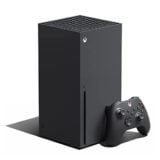How can any Xbox studio trust Microsoft now?
For Xbox’s hugely expanded gaming division, anything that isn’t Call of Duty is now a failure, and that’s a problem
Julian Benson

It’s now clear that when Microsoft completed its $75 billion buyout of Activision-Blizzard in October last year, it fundamentally changed the makeup of its Xbox division and, in the process, put all of its other studios in jeopardy.
We already saw one impact of the acquisition in January when Microsoft laid off over 1,900 staff from the Xbox division. CEO Phil Spencer said at the time that affected staff were in “identified areas of overlap” with the newly acquired studios.
However, I suspect the studios Microsoft closed this week were shuttered for an altogether different—but no less depressing—reason: continued revenue growth.
Purchasing Activision–Blizzard has done more than put a huge debt on Microsoft’s ledger; it’s also significantly increased the Xbox Division’s revenue. That may not sound like much of a problem, but it shifts the scale of everything the company does and needs to do to continue growing.
Reading Microsoft’s quarterly earnings reports can give you a sense of how significant the change has been. In January, in the first filing since the Activision-Blizzard acquisition was completed, Xbox’s content and services revenue grew by 60%, 55% of which came from the newly owned teams . The revenue from Activision-Blizzard’s games now makes up more than a third of all the money from the Xbox division.
All of the studios Microsoft had previously bought, including Minecraft-maker Mojang and the $7.5bn acquisition of Zenimax Media, the publisher of Bethesda Softworks, Id Software, and Machine Games, have been dwarfed by the addition of Activision-Blizzard.
For a sense of the difference, in the previous year’s financial report , Microsoft said a 5% growth equated to $36m, so 55% growth is in the region of $400m. After the Activision-Blizzard buyout was completed on October 13 last year, Xbox became a fundamentally different and larger company, operating on a different scale than before.

To satisfy shareholders, Microsoft must continue showing growth. Anything less than increasing revenues looks like a failure, impacting the company’s share price. We know this is on Xbox CEO Phil Spencer’s mind because he said as much in March this year.
“The thing that has me most concerned for the industry is the lack of growth,” Spencer said in an interview with Polygon . “When you have an industry that is projected to be smaller next year in terms of players and dollars, and you get a lot of publicly traded companies that are in the industry that have to show their investors growth — because why else does somebody own a share of someone’s stock if it’s not going to grow? — the side of the business that gets scrutinised is the cost side. Because if you’re not going to grow the revenue side, then the cost side becomes challenged.”
The problem Microsoft faces—and it was one entirely of its own making—is that it now owns a string of studios working on games that, when compared to Activision-Blizzard’s titles, will barely move the needle in terms of revenue growth.
For evidence of this change, look to a statement Xbox marketing VP Aaron Greenberg made in April last year, before the Activision-Blizzard acquisition. Speaking of Tango Gameworks’ Hi-Fi Rush, he said the game “was a breakout hit for us and our players in all key measurements and expectations.” Yesterday, Microsoft closed the studio.
What was a success last year has clearly been recontextualised by the new scale Microsoft is working to. The cost side of Tango Gameworks became challenged in light of an updated balance book.
“The problem Microsoft faces—and it was one entirely of its own making—is that it now owns a string of studios working on games that, when compared to Activision-Blizzard’s titles, will barely move the needle in terms of revenue growth. “
This puts every one of Microsoft’s earlier acquisitions in a horrible position. InXile, Double Fine, Undead Labs, Ninja Theory, and Obsidian Entertainment all make fantastic games, some of which have been massive hits for studios of their scale, but put alongside World of Warcraft and Call of Duty, they’re small fry.
Even if it’s profitable, how many copies will Hellblade 2 need to sell for Ninja Theory’s title to look like a worthwhile cost alongside the revenue generated by the next Call of Duty?
There’s been little sense to Microsoft’s strategy in the past decade, it seems to simply acquire whatever it can lay its hands on with little regard for the studios it already owns or the titles they’re working on.
Imagine being in Obsidian Entertainment’s shoes right now. When it was acquired by Microsoft in 2018, it was put to work on a first-person fantasy RPG that would appeal to the same players as the Elder Scrolls series. Although set in the world of the Pillars of Eternity games, its shift in perspective effectively made it a new franchise and the budget and sale expectations would have been set to that reality.
Then, in 2021, Microsoft acquired Bethesda and the Elder Scrolls series, so now Obsidian is making a game that competes with another studio in its owner’s portfolio. When Avowed releases later this year, its earnings will sit on a spreadsheet that includes the game it has little hope of surpassing in this first iteration. Higher up on the sheet still, there will be multiple Activision-Blizzard games that all earn significantly more.

Many of Microsoft’s studios are in a similar position; they’re committed to multi-year development cycles of games that no longer live up to the scale Microsoft’s shareholders demand.
In his statement announcing yesterday’s studio closures, Xbox Game Studios head Matt Booty said, “These changes are grounded in prioritising high-impact titles and further investing in Bethesda’s portfolio of blockbuster games.”
This is speculation on my part, but I wonder now more than ever if Obsidian’s future will involve a shift from Avowed and The Outer Worlds to The Elder Scrolls and Fallout. It’s what shareholders will be asking, and has Phil Spencer proven himself constant enough to resist that questioning?
As for Microsoft’s other studios, what confidence can they now have that they fit into the updated forecasts for Xbox’s future?














